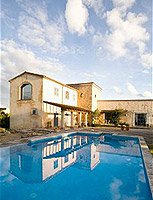10 Tips for Better Real Estate Photos
August 31 2012
 Good real estate photos are essential for turning people casually browsing listings into potential leads. If the photographs of your listings are grainy, badly lit, or poorly composed, you may be losing out on buyers. Our guide to great interior and exterior shots provides easy tips for beginners that can improve the quality of your photos.
Good real estate photos are essential for turning people casually browsing listings into potential leads. If the photographs of your listings are grainy, badly lit, or poorly composed, you may be losing out on buyers. Our guide to great interior and exterior shots provides easy tips for beginners that can improve the quality of your photos.
Primary Exterior Shot
The most important photo you'll take for any listing is called the "primary exterior shot." Required by most MLSs, this portrait of a home and its grounds will be the first thing potential buyers see and what motivates them to investigate a listing further.
Here are a few tips to make the most of this crucial photo:
- Increase camera elevation. It's amazing what a little height can do! Called "pole aerial" photography by professionals, shooting from an elevated position helps enhance shots of tall homes, houses atop hills, and portraits of property grounds.
As most agents aren't going to have access to aerial equipment, try shooting your primary exterior shot from a ladder! - Take three-quarter shots. Photos taken at a slight angle, instead of straight-on, are usually stronger and more dynamic. Try to avoid large expanses of driveway or views of the street in this shot, as they distract attention from the home.
- Show as many home features as possible. As the "book cover" your listing will be judged by, it's important to get as many key property features into this photo as possible. Don't be afraid to venture away from the front of the house! Homes with pools or other water, outlying buildings, or impressive grounds can benefit from shots taken from the rear of the property.
- Take multiple shots. Your best photo may not be what you think it is while on a shoot. Photographers will often discover the best photos only after they've uploaded them to their computer. Don't be afraid to experiment with multiple shots from different angles and elevations. After all, the beauty of digital photography is that you can take as many photos as your memory card can handle!
- Shoot during "the golden hour." Proper lighting is one of the most important elements of a good photo. Shots taken during "the golden hour"--the hour after sunrise and the hour before sunset--avoid the harsh shadows and overexposure of photos taken at midday. Find out when the golden hour takes place in your area at golden-hour.com to take advantage of this time's soft lighting and warm hues.
Interior Photos
While a strong exterior shot is what attracts leads to your listing, good interior photos are what draws them in. These shots should showcase the best features of the inside of a home and, above all, be inviting. They should help prospects envision themselves living inside the home. If they don't, leads may very well move on to the next listing.
- Use a wide angle lens. The maximum 35mm setting of most point-and-shoot cameras can take decent interior shots. For truly great photos, however, consider investing in a wide angle lens of 28 or 24mm. You will be able to capture more of a room, and more of its features, in a single shot.
- Know your subject. Find the greatest selling point of the room you're photographing and make that your subject. Don't be the amateur shutterbug who takes a picture of a living room, only to obscure the gorgeous fireplace with a couch or chairs that will be leaving with the current owner. Furniture should never be your focus; if it's too prominent in the shot you're considering, move to a new angle that emphasizes the permanent features of the home.
- De-clutter. The best way to emphasize your subject is to get rid of all distractions. You want your photo to be as simple as possible. Remove objects from tables and desks, or extra pillows from the couch. Re-arrange furniture if you have to. Remember, when it comes to interior photos, less is definitely more.
- Shoot into corners. While not a hard and fast rule, this simple trick can make small spaces feel larger.
- Pay attention to lighting. A big distraction in interior photos is harsh daylight coming through the windows. To balance this out, draw the curtains and keep interior lights on. (Of course, if the view from a certain window is a selling point of the home, avoid drawing the curtains.) Some photographers will replace fixture light bulbs with brighter ones, though this is recommended only if you know a little about electricity.
Never use your on-camera flash, as its light can make the room look strange. Instead, increase your camera's ISO for a slower shutter speed, or use an external flash unit.
Finding Professional Photographers
No time or inclination to learn photography? Consider hiring a professional! Check out our directory of photography services to locate one.
An alternate way to find real estate photographers is to browse listings in your MLS for photos that catch your eye. Simply call the agent whose listing impresses you, compliment their photos, and ask if they use a professional. If so, ask for the contact information and you'll have a photographer whose work you already know you like.
